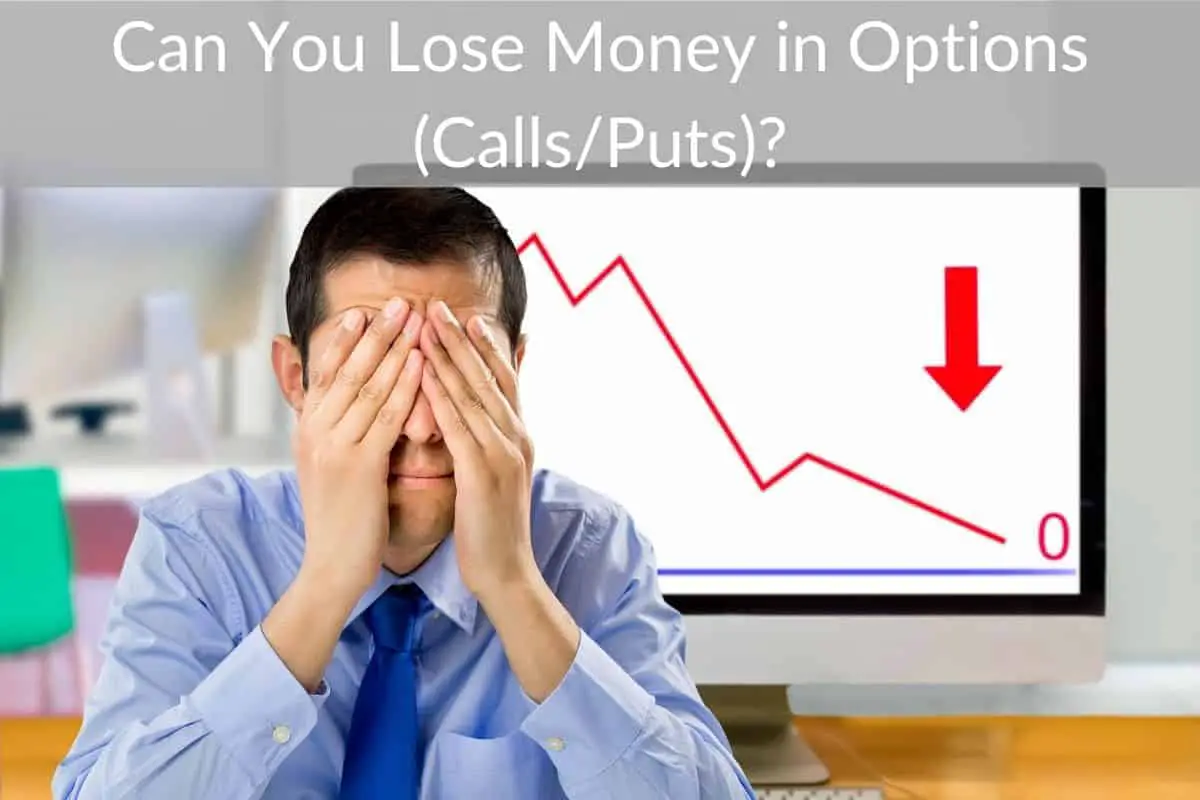Table of Contents
*This post may contain affiliate links. As an Amazon Associate we earn from qualifying purchases.
Call options increase in value when the underlying stocks rise in price, while put options increase in value when the stock price dips. Thus, investors are expecting a stock’s upward movement by buying call options and on a stock’s decline by purchasing put options.
Still, both option trading strategies offer a couple of similar risks and benefits.
You can lose money in options if the call or put expires worthless or trades below the strike price. When selling calls and puts, you assume all risks if the stock fails to move favorably.
So, while selling calls and puts exposes you to capped losses, you could lose more than the premium received. If you purchase a call or put option the amount of money you can lose is capped at what you paid to buy that option.
Say for example you buy 1 contract for ABC stock and that call option has a $1 premium. Since almost all option contracts are for 100 shares, buying that call option would cost you $100 ($1 x 100 shares).
The most you could ever lose on that call option is that $100.
In this article, you will learn more about how you can lose money in options and the maximum amount you can expect to lose.
How You Can Lose Money in Options
When trading options, the guiding principle is what the stock’s value will be at a future date. Thus, buying a call option is betting the stock will be worth more, while selling a call option is betting that it will be worth the same or less.
Conversely, buying a put option is betting that a stock will be worth less, while selling a put is betting it will be worth the same or worth more.
To realize a profit on a call option, the stock needs to move above the predetermined price by a margin large enough to offset the premium paid. It can also realize a profit if the stock quickly moves up towards the strike price and you sell the call.
However, you can lose your entire investment if the underlying stock fails to rise above the strike price prior to expiration and you don’t sell the call.
Thus, with options, you have to predict the stock’s direction correctly, and the timing, too, since the option comes with an expiration date. But as a call buyer, your total loss remains capped at your initial investment.
While call sellers typically receive the contract premium, they have to deliver the stock at the agreed-upon price if the buyer exercises the stock option. Theoretically, the potential the call option seller could miss out on millions of dollars in profit if the stock price skyrockets.
However, in reality the most that the call seller will miss out on is a few dollars per share.
If buying a put option and the underlying stock remains at the strike price or slightly above it, the put is said to be out of the money. Thus the option expires worthless. In this case, the put seller retains the premium for the put while the buyer loses out on the entire investment.
Short selling a put option provides less profitability if the stock declines. Fortunately, short sellers typically have a longer time for the stock to decline, though potential losses can be infinite if the stock were to continue to soar.
You could lose more than what you put into your initial position, or you might need to put up more capital to maintain the position.
For naked put sellers, the downside is quite significant. If the buyer exercises the put option, then you must purchase 100 shares of stock at the strike price. What this means is that your potential losses could go beyond your initial investment. What’s more, if the underlying stock price went to $0, the loss could amount to the value of the entire stock.
Options can also lose money or go down in price due to the following factors:
- Time decay. Options have an expiration period. Once they run out of time, they expire. This means that your option premium is losing money daily. However, the premium portion of the option is the only one that suffers from time decay, decaying faster the closer you move towards expiration.
- Implied volatility. Implied Volatility and Vega can both change rapidly, affecting option premiums negatively. And because the effects can be sizable, it’s essential for you to understand the effects of volatility.
- A wide bid/ask spread. An option that moves deep in the money is less appealing to speculators, leading to reduced volume on the option. This situation could cause market makers to widen the option’s bid/ask, making your account appear to be losing money.
Can You Lose More Money in a Put Option?
When buying either calls or put options the most that you can lose is the premium that you paid to buy the option. So you cannot lose more then the original premium no matter which type of option you buy.
Therefore, when buying puts, your total loss is the premium amount you already put up or paid for buying the put option and no more.
What’s the Maximum Amount You Can Lose on a Call Option?
The maximum amount you can lose on a call option as a call buyer is the premium paid. So if you pay $200 to buy a call option then that is the most that you can possibly lose.
In a nutshell, your maximum loss depends on two things; whether you’re going long or short on the option. The most you can lose if you’ve purchased the call option (going long) is only the premium you paid for the options contract.
However, you can lose more when selling a call option as theoretically the stock could go to zero. Assuming you sold a covered call you would have to own 100 shares of a stock to sell one option contract.
So if that stock drops significantly you would lose a good amount of money on those shares that you hold.
Therefore, if buying a call, losing your entire investment can be a possibility if the stock dips in value and the option you bought moves to zero. In other words, you can lose all the full premium paid if, upon expiration, the option has no intrinsic value and you didn’t sell it prior to expiration.
This can happen rather quickly in options trading.
Final Thoughts
Trading options can be a risky undertaking. As such, it’s essential to understand the risks of every position you get into since you could lose all the money that you paid for the call or put option.
Still, when used correctly, options can limit your risks while enabling you to make large profits from a stock’s gain or loss. But with either call or put options, once you make a purchase, the actual purchase price is also the maximum loss you can make.

